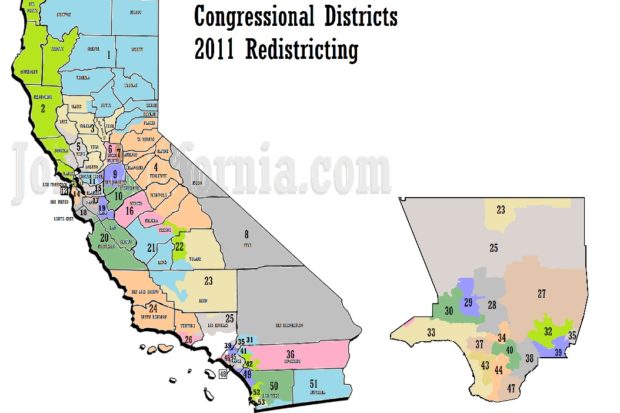
With the California electorate passing Prop 11 in 2008 and Prop 20 in 2010, the landscape for redistricting is significantly different than was the case in previous decades. Prop 11 shifted the process of redistricting from the state legislature to the newly formed Citizens Redistricting Commission (CRC) for the State Senate, the State Assembly and the State Board of Equalization. Prop 20 extended the purview of the CRC to include Congressional redistricting.
Proponents of Props 11 and 20 contended, among other things, that it was a conflict of interest for the legislators to be drawing the boundaries of their own districts. The League of Women Voters and Common Cause were two organizations at the forefront of drafting Prop 11, paying to collect the necessary signatures to qualify it for the ballot and then campaigning to get it passed.
The CRC is a multi-partisan commission, appointed through a complex selection process, that comprises five Democrats, five Republicans and four persons from other parties or unaffiliated. When the CRC completes its work, there is a high threshold for agreement as three Democrats, three Republicans and three of the others must all agree on the outcome. If the CRC fails to reach an agreement by its deadline, the process is turned over to the California Supreme Court.
Prop 11 changed the state constitution such that a number of criteria were designated and prioritized for determining district boundaries. Those criteria can be summarized as follows:
- Reasonably equal population
- Compliance with the Voting Rights Act
- Contiguity
- Respect existing city and county boundaries
- Respect neighborhoods and communities of interest
- Compactness
- Nesting of two Assembly districts within one Senate district
- Residences of incumbents cannot be taken into consideration
Furthermore, the CRC was tasked with holding public hearings throughout the state to receive public input relative to the defining of boundaries around neighborhoods and communities of interest. That process is currently under way.
To educate the populace about this new redistricting process, a number of nonprofit organizations have held seminars and trainings throughout the state. A primary goal of these informational activities is to prepare residents for making presentations to the CRC that will be meaningful and effective.
The hearings have focused on public definitions of the catchphrase community of interest (COI). Racial minorities are the best-known COI. However, a COI can be defined in any number of ways. These definitions might include geography, social and economic factors, lifestyles and interests, community assets or the absence of such, and changes occurring within an area.
In defining a COI for the CRC, the point is to make a sufficient argument that the COI as defined should not be split into multiple districts. Furthermore, COIs that are similar might also be grouped together to ensure representative voting strength. Of course, one person’s COI could be another person’s “interest group,” so the importance of a strong argument before the CRC is essential in defining a COI.
Even though the criteria for the CRC’s decision making are well-defined, there are inherent conflicts between them. For example, one criterion asks map makers to follow natural and geographic boundaries, including city limits and county lines, when drawing districts. On the other hand, there is a requirement that the Voting Rights Act be followed. When these two rules are in conflict, the Voting Rights Act takes precedence. As a result, one possible COI (the City of Fresno) would be trumped by another COI (the Hispanic community). Thus, redistricting is as much a craft as a science.
Under the Voting Rights Act of 1964, it is unconstitutional to “dilute” the voting power of racial minorities through the drawing of district lines. “Cracking” has often been practiced, which is the process of drawing district lines to prevent this type of majority-minority district. According to Section 2 of the Voting Rights Act, if it is possible to draw a majority-minority district, then one must be created.
The CRC intends to release a draft map of the new districts on June 10. That will be followed by a public review period and another round of public hearings. The CRC will take public testimony at a public hearing in Fresno on June 23 from 6 p.m. to 9 p.m.
There remains ample opportunity to provide input to the CRC (see sidebar). To get involved or for more information, contact 559-790-3495 or data.nations@gmail.com.
Redistricting Resources
The Greenlining Institute reports that “many Californians do not know about redistricting or that they can play a key role in ensuring that their voice and their vote matters.”
You can influence redistricting at the state and Congressional levels by submitting documentation directly to the Citizens Redistricting Commission or presenting testimony at one of the public hearings. There will be a public hearing in Fresno on June 23. The commission needs to hear about your community of interest to ensure that the state’s redistricting maps reflect the neighborhoods we live in.
- Receive free mapping help at the Redistricting Assistance Site in Fresno, 1713 Tulare St., Suite 130. Hours: Wednesdays 3 p.m.–9 p.m., Thursdays 3 p.m.–9 p.m., Saturdays 9 a.m.–4 p.m. or by appointment (Wednesday–Saturday). Troy Mattson, 559-272-8130, tmattson@law.berkeley.edu.
- Astrid Garcia of the National Association of Latino Elected and Appointed Officials (NALEO) is a liaison to support community organizations that wish to influence redistricting in Fresno County. 213-747-7606, ext. 4434, agarcia@naleo.org.
- NALEO Educational Fund Redistricting Web site: www.latinosdrawthelines.org.
- California Citizens Redistricting Commission: www.wedrawthelines.org. Includes resources and a calendar of public meetings.
- Statewide UC-Berkeley Database Web site: http://swdb.berkeley.edu/index.html.
- Redistricting California collaborative Web site: www.redistrictingca.org.
- Access the 2010 Census data and map your community at www.ReDrawCA.org.
- The Mexican American Legal Defense Fund (MALDEF), the NAACP Legal Defense Fund and the Asian American Justice Center have published The Impact of Redistricting in YOUR Community: A Guide to Redistricting, which is available at www.maldef.org/assets/pdf/Redistricting.pdf.
- U.S. Census Bureau 2010 Redistricting Data: http://2010.census.gov/news/press-kits/redistricting.html.
